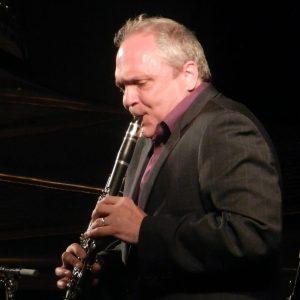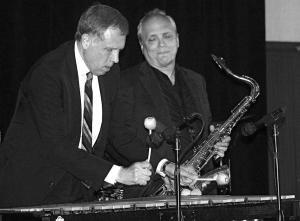It was a jazz critic from Great Britain writing for the BBC in 2013 who anointed Ken Peplowski with superstar status when he declared that the versatile clarinetist from Garfield Heights, Ohio, is “arguably the greatest living jazz clarinetist.” He was the 2014 recipient of Sarasota Jazz Festival’s “Satchmo Award” given for his “unique and enduring contributions to the living history of jazz,” and he’s been inducted into the Jazz Cruise Hall of Fame.
He’s been touted as a worthy successor to Benny Goodman, especially in terms of similar tone and virtuosity, and the fact that both are considered “crossover” musicians who seriously perform classical music in addition to jazz. The comparison has also been made that Peplowski sounds the way Goodman might sound today if the legendary King of Swing had continued to polish his craft and expand his musical purview into the 21st Century.
Ken has great respect for Goodman, calling him “one of the greatest clarinetists of all time, as well as an outstanding bandleader whose bands will always rank among the very best in the annals of jazz. Benny was such a giant figure that he is almost unparalleled.”
Background
 Ken Peplowski came from a family where there was always music in the house. His father was an amateur musician who played the accordion, and his older brother Ted took up the trumpet. The three family members were in a Polish polka band, the Harmony Kings, where Ken said he learned his craft “by doing it. When you grow up in Cleveland and play in a Polish polka band, you learn to think on your feet in a hurry.”
Ken Peplowski came from a family where there was always music in the house. His father was an amateur musician who played the accordion, and his older brother Ted took up the trumpet. The three family members were in a Polish polka band, the Harmony Kings, where Ken said he learned his craft “by doing it. When you grow up in Cleveland and play in a Polish polka band, you learn to think on your feet in a hurry.”
After his first public appearance, he recalled, “I knew this is what I wanted to do, and I enjoyed actually making money at that early age.” By the time he was in high school, he was writing music for an assigned project and playing in the school stage band, teaching at the local music store, and playing jazz gigs around town while still getting up early every morning for school. “It let me be creative, and it’s where I learned to improvise and about chord changes, and how to ‘fake” songs. It was like learning to swim by getting thrown in the water.”
He went on to attend Cleveland State University as a music major where the curriculum emphasis was on classical music. To keep his jazz chops, Ken would sneak off to play with local jazz bands on weekends to help pay for his tuition.
With the Dorsey Band
In the late ’70s, Ken had a quartet and was playing at a Cleveland jazz festival where he was heard by Buddy Morrow, leader of the Tommy Dorsey Orchestra, who made him an offer on the spot to join the band to not only play lead alto, but also perform a featured number on clarinet with the rhythm section. He was with the band for two and a half years, describing the experience as “a great road-school playing one-nighters 48 weeks out of the year.”
While on the road with the Dorsey band, Ken met the late saxophonist Sonny Stitt and had the opportunity to study with him. “He was an inspiration to all of us who make a living performing on the road. I’ve never heard anyone play with such amazing consistency as Sonny in all kinds of settings.”
After a short tour with the road company of the Broadway show, Annie, Ken moved to New York City in 1980 and was soon playing everything from Dixieland to avant-garde jazz. “Playing all those weddings and private parties and working at jazz clubs like Condon’s was a terrific experience, because you learn to deal with the unpredictable.”
With Benny Goodman
In the mid-80s, Benny Goodman came out of retirement to lead what was to be his last band. It included Ken and such stalwarts as Bucky Pizzarelli, Dick Hyman, and Flip Phillips. Goodman was known for his impatience with musicians who didn’t perform up to his standards and would often fire, on the spur of the moment, those who hit the wrong notes. (Some did get rehired, however, when Benny cooled down.) Ken, who had become the band’s unofficial “straw boss,” was one of two band members who wasn’t unceremoniously ushered off the bandstand.
Although that band was together for only about a year and played limited engagements, the experience had a significant impact on Peplowski. (He shared some of his thoughts regarding Benny Goodman in a 2013 interview with Jesse Cloninger, when both were involved with the Oregon Festival of American Music. An edited version is capsulized in a separate article in this issue.)
The Present
Currently on the road roughly half the year, Ken has played everything from small clubs to the Hollywood Bowl for a sold-out concert. He’s been on the stage of Radio City Music Hall sharing the billing with Frank Sinatra and Ella Fitzgerald. He’s headlined in Las Vegas, the Newport Jazz Festival, pops concerts and European festivals, and been on soundtracks for Woody Allen films.
His versatility will be on display at the Siletz Bay Music Festival in Lincoln City, Oregon when he will be participating in two weeks of jazz and classical music performances and community outreach programs. He is scheduled to perform the first movement of Max Bruch’s Double Concerto for Clarinet and Viola, op. 88, and Brahms’s Trio in A Minor, op.114, along with a Benny Goodman medley and a tribute to Leonard Bernstein, plus hosting “An Evening of Comedy and Music” with comedian Pete Barbutti.
He enjoys doing intimate house parties, of which he does about 10 a year, mainly in New York and California:
“These are mainly ‘add-on’ engagements to an existing tour or concert commitment. The host will put me with a group of musicians of his choice, which gets me playing all kinds of different music. We don’t rehearse, and it all usually happens in somebody’s living room. So we’re creating something right in front of the audience, after which we have an open forum. It’s a fun evening and provides those in attendance with a look inside of what we do as musicians when we collaborate with other people.”

Known for his humorous outlook, he admits, “I love being on stage, but I sometimes get bored. That’s when the jokes come in handy. It’s not a crime to show that you enjoy what you are doing.” When he’s a sideman on another musician’s gig, he is always the total professional and makes no effort to upstage the lead artist.
Ken has recorded some 50 CDs as a soloist and been a sideman on over 400 albums with other artists. He says he’s most proud of his recordings because “They capture what I do and hopefully have made an impact on people.” He’s just recorded a Big Band CD for Arbors Records and has even done a couple CDs that sell with Menus & Music interactive cookbooks.
Always willing to give back to his profession, Peplowski does workshops for students of all ages and abilities. “My goal is to get students to learn how to teach themselves and how to bring out their own best qualities. After all, jazz is about individuality. First, you learn the rules, and then you figure out how to break them. I like to think of myself as a lifelong student.” The advice he gives to aspiring young musicians is “You must have a burning desire to succeed more than anything in your life.”
Asked what’s ahead, he responds, “Who knows. I love all kinds of music, and I’d like to find more opportunities to bridge the gaps between different musical styles. I consider myself an interpreter of material. If something interests me, I try to put my own spin on it without thinking or worrying about playing a particular style. Basically, I like a challenge. I’m a sucker for a good melody, and I love playing for audiences, big or small.”
Related: Ken Peplowski- My Final Interview about Benny Goodman, Good News: Ken Peplowski Back on the Road
Lew Shaw started writing about music as the publicist for the famous Berkshire Music Barn in the 1960s. He joined the West Coast Rag in 1989 and has been a guiding light to this paper through the two name changes since then as we grew to become The Syncopated Times. 47 of his profiles of today's top musicians are collected in Jazz Beat: Notes on Classic Jazz.Volume two, Jazz Beat Encore: More Notes on Classic Jazz contains 43 more! Lew taps his extensive network of connections and friends throughout the traditional jazz world to bring us his Jazz Jottings column every month.






















